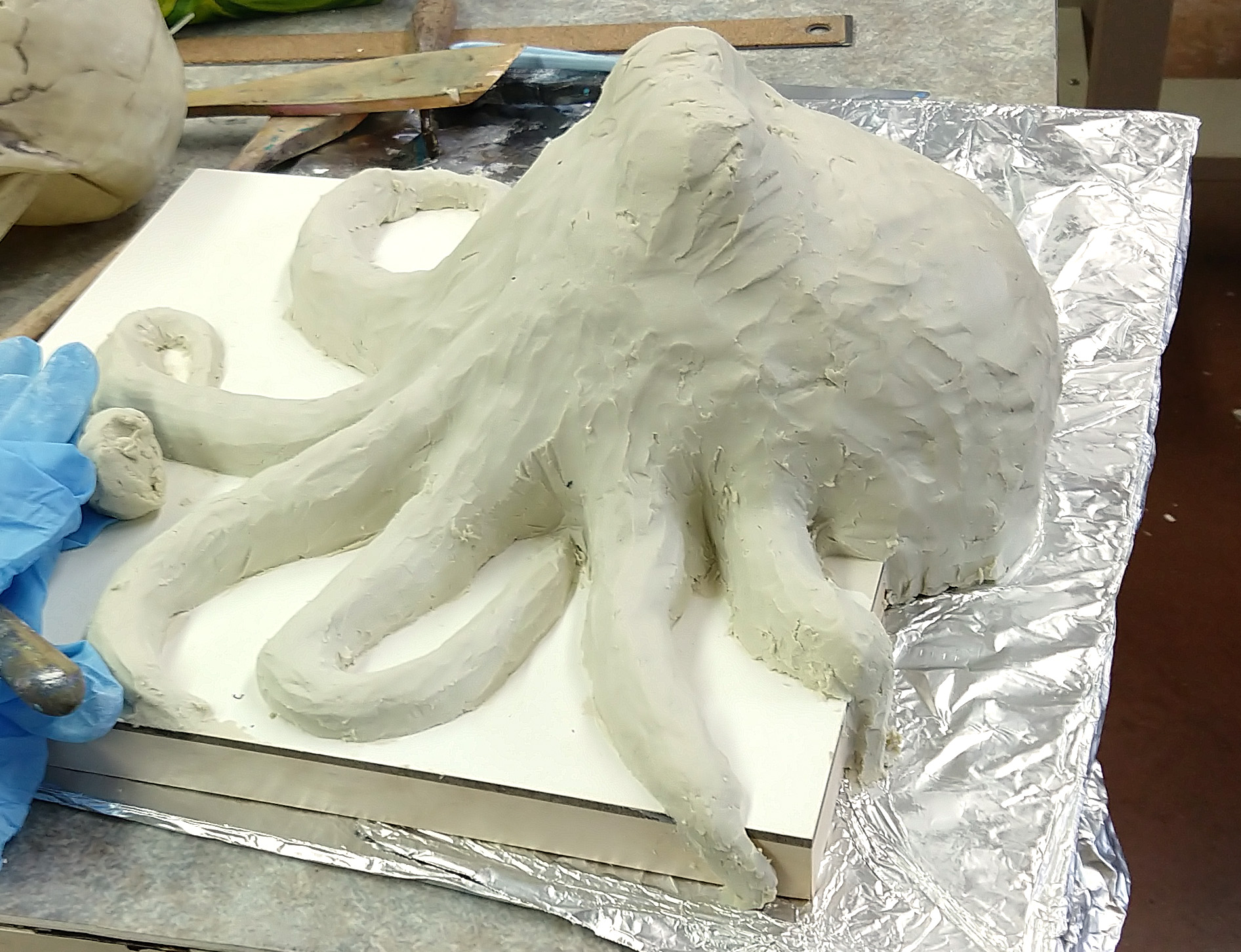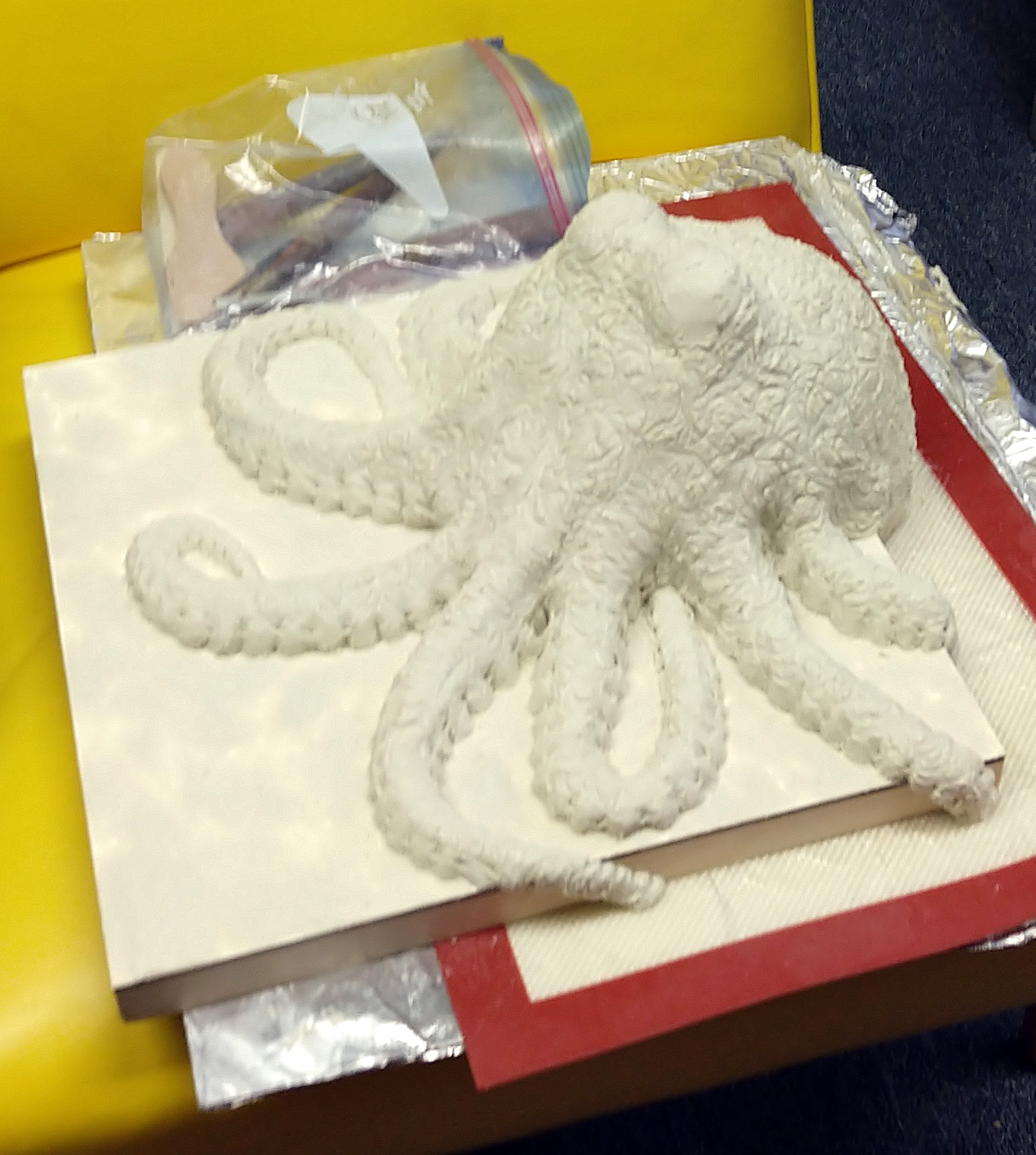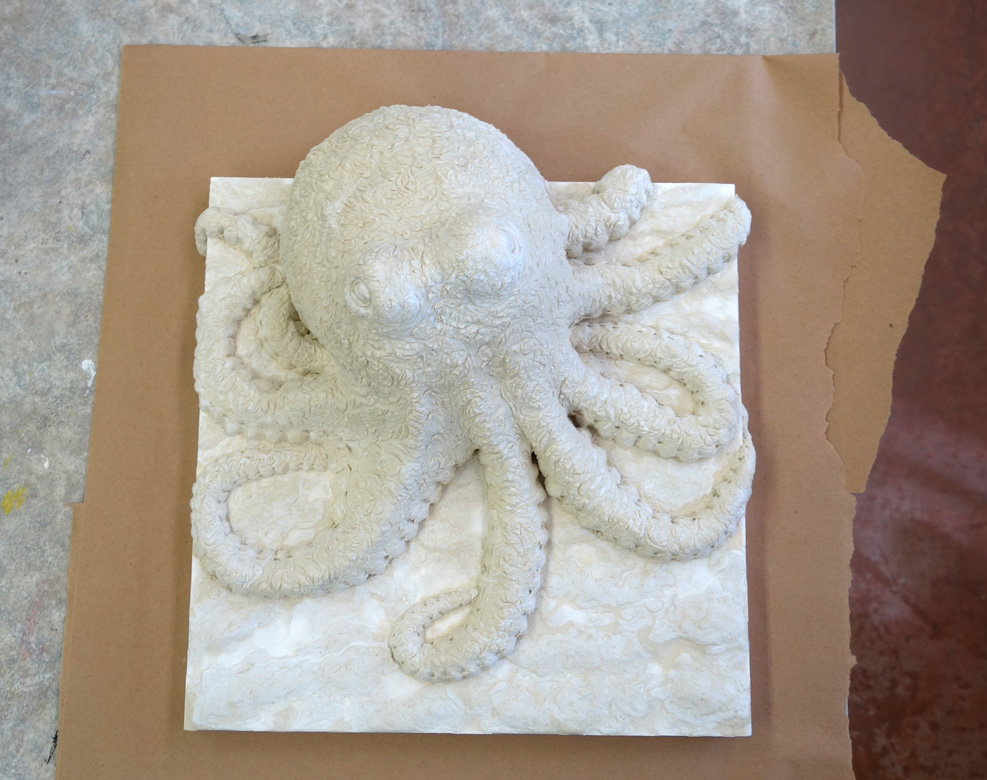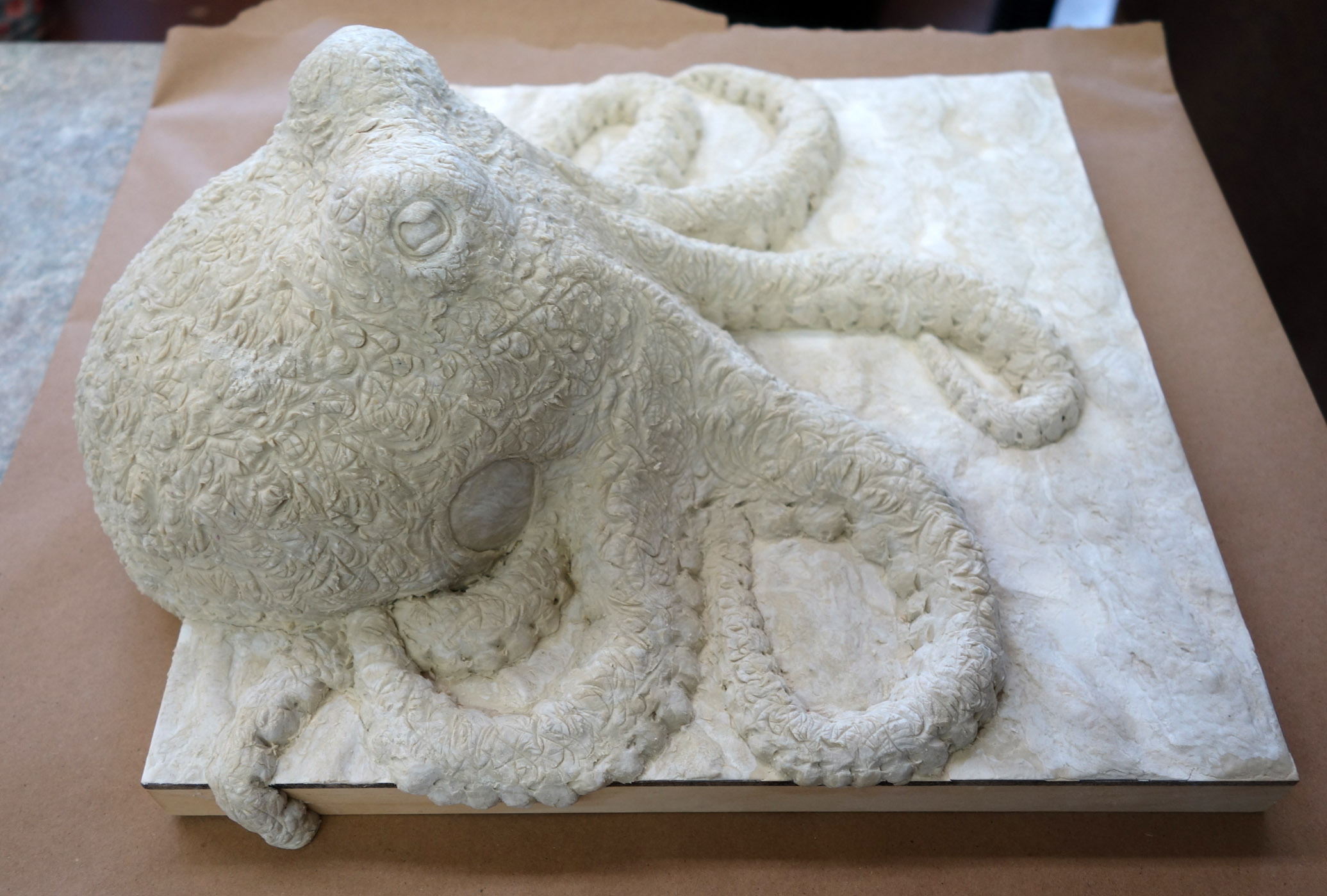Here is a new diptych, meaning partner pieces that will always be shown together. Diptychs can also be framed or otherwise physically linked together, too, but in this case I am framing them separately. These are mixed media pieces including sycamore leaves, methylcellulose, toner, and acrylic on artisanal handmade papers. The first paper is a very eco-friendly renewable dyed banana paper that I collaboratively made on a former residency in Peru, and the second is a handmade silk paper from Ato Menegazzo Papeles in Buenos Aires.
New Artwork
BROTA and Buenos Aires Artwork Series "Gardens of Memory"
As you can see in this earlier post, I worked atop two very large trunk cross-sections for a permanent outdoor installation. I also worked atop smaller trunk and/or branch cross-sections as well. Here are four new pieces in my “Gardens of Memory” series. The series is so titled because the substrate is very directly a part of a once-living tree (paper is too, but in a more distanced form), and the images atop it are from various botanical gardens I’ve frequented.
BROTA and Buenos Aires Outdoor Installation Pieces
Here are two partner pieces I created to donate and install permanently in Buenos Aires after I leave with the help of BROTA! They are both mixed media pieces including acrylic, methylcellulose, toner, and marine varnish on a tree trunk cross-section, and will be diagonally mounted on wooden poles outdoors when installed. The institution that will host these works is yet to be determined. The two pieces are part of my Garden Memories series.
BROTA and Buenos Aires Artwork Series "Transmigration Landscapes" Preview
With permission from the Buenos Aires Botanical Garden, I have been taking plant samples and using chromatography to create a series of very literal plant self-portraits that also function as abstract landscapes. I am titling this series Transmigration Landscapes. There are 35 of these portraits, as well as 2 test designs that I liked enough to keep as well. Since I currently don’t have access to a scanner, processing photos of each to share clean images of the work requires a significant investment of time, so I figured I’d share a peek now with the promise of more to come!
BROTA and Buenos Aires Artwork 1
I’ve been working on two different series of artwork from the start using the new-to-me methylcellulose and chromatography papers, but both are very experimental and I’m not sure exactly what the finished products should even look like at this point. That’s why I’ve yet to reveal much in terms of production other than a couple early test images from the chromatography papers.
However, I started feeling anxious about how experimental I’m being - of course it’s good to experiment, but I wanted the comfort of completing a more traditionally “me” type of piece with a clear end point. Plus, I bought those artisanal handmade papers from Ato Menegazzo Papeles, and it would be a shame not to even work on some while here!
This not-quite-finished painting is of a dwarf water hyacinth, Eichhornia crassipes. The common names in Spanish for this plant are (as per Wikipedia): jacinto de agua, flor de bora, camalote, aguapey, lechuguín, tarope, tarulla o reyna. I chose this plant in particular because I love how graphic and full of character it is, and the fact that it’s an aquatic plant means that the whole of the plant, including its root system, can be shown in a figure-ground relationship that also celebrates the handmade paper. Water hyacinth is an ornamental plant that is occasionally consumed and used medicinally, but is also highly invasive in warm climates and is often illegal to own or sell. An interesting dichotomy that inspired my current tentative title: Adrift.
New Artwork: Catalyst
Here’s some new artwork to kick off a new year! This piece was inspired by my encounter with two octopi on my last scuba dive this summer with Silviu in Arinaga while on residency at La Pedrada de Noemí. It’s pretty unusual to see the common octopus, Octopus vulgaris, out and about during the day as they are typically nocturnal predators, but it was a very windy day with a lot of churning water and that must have drawn them out.
I have titled this piece Catalyst. It is mixed media including QuickCure Clay, aquabord panel, acrylic, and QuickCure Glaze Coating. Catalyst is capable of being displayed on a pedestal or installed on a wall. It is 13.5x14.5x6.25".
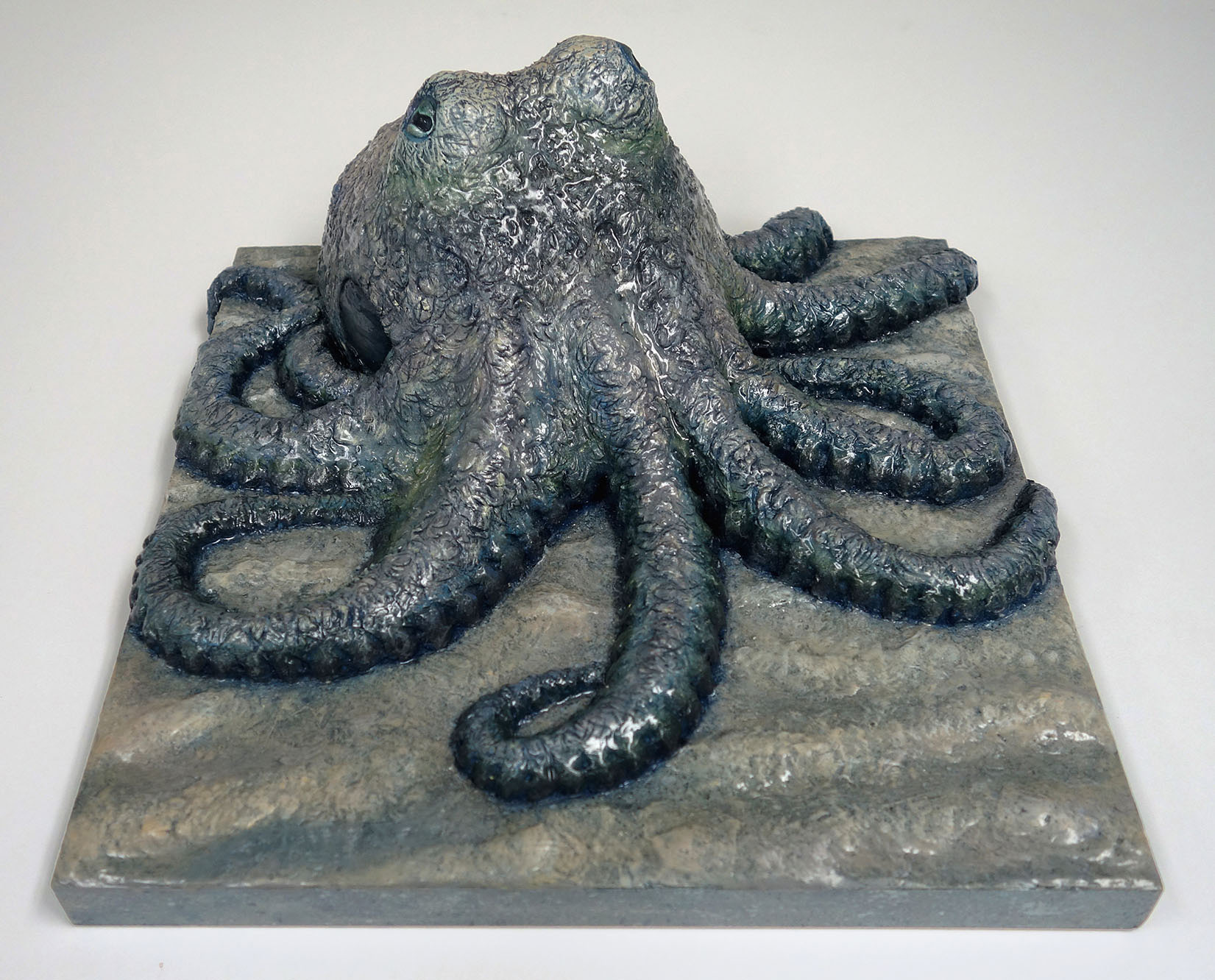
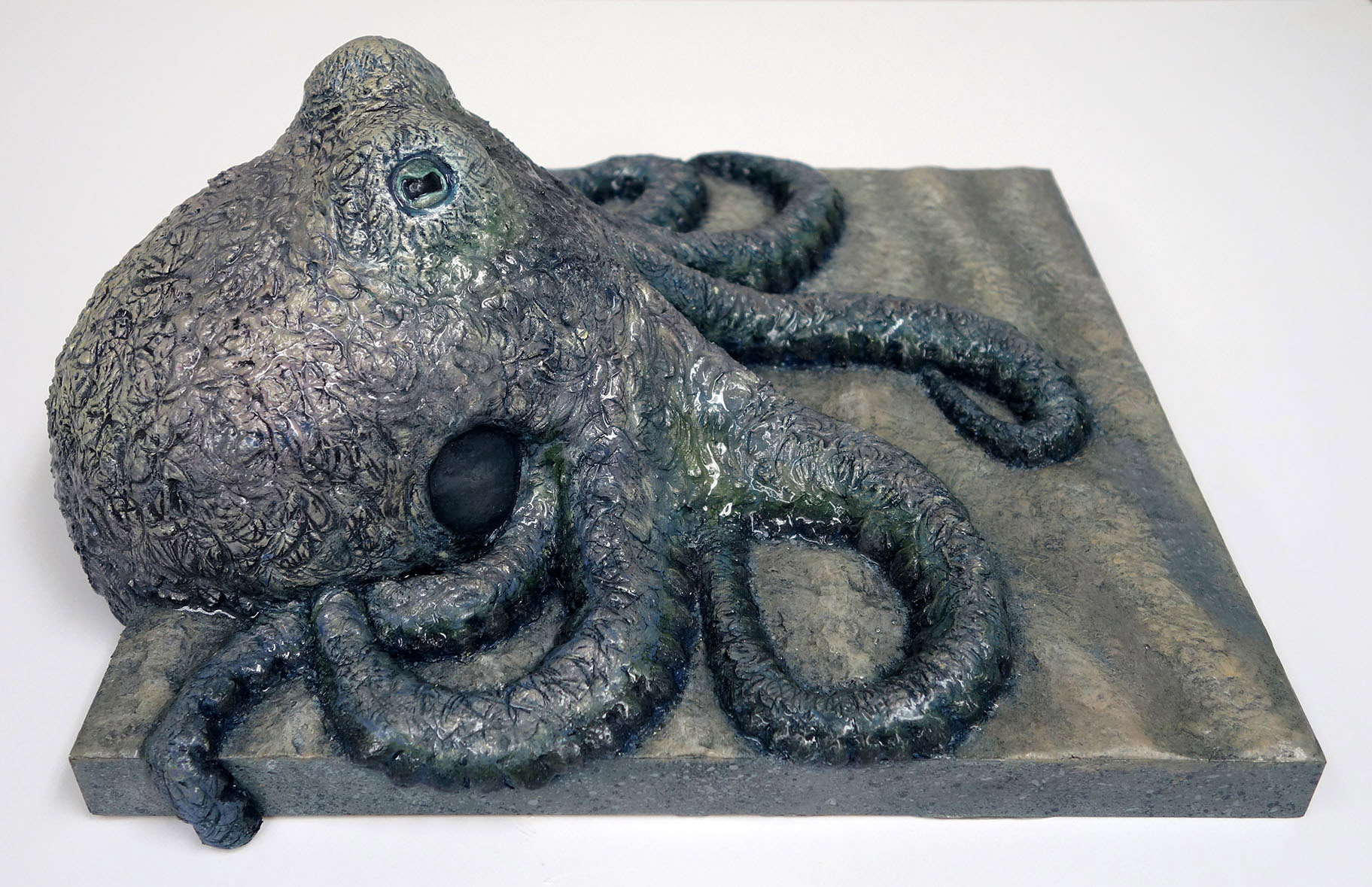
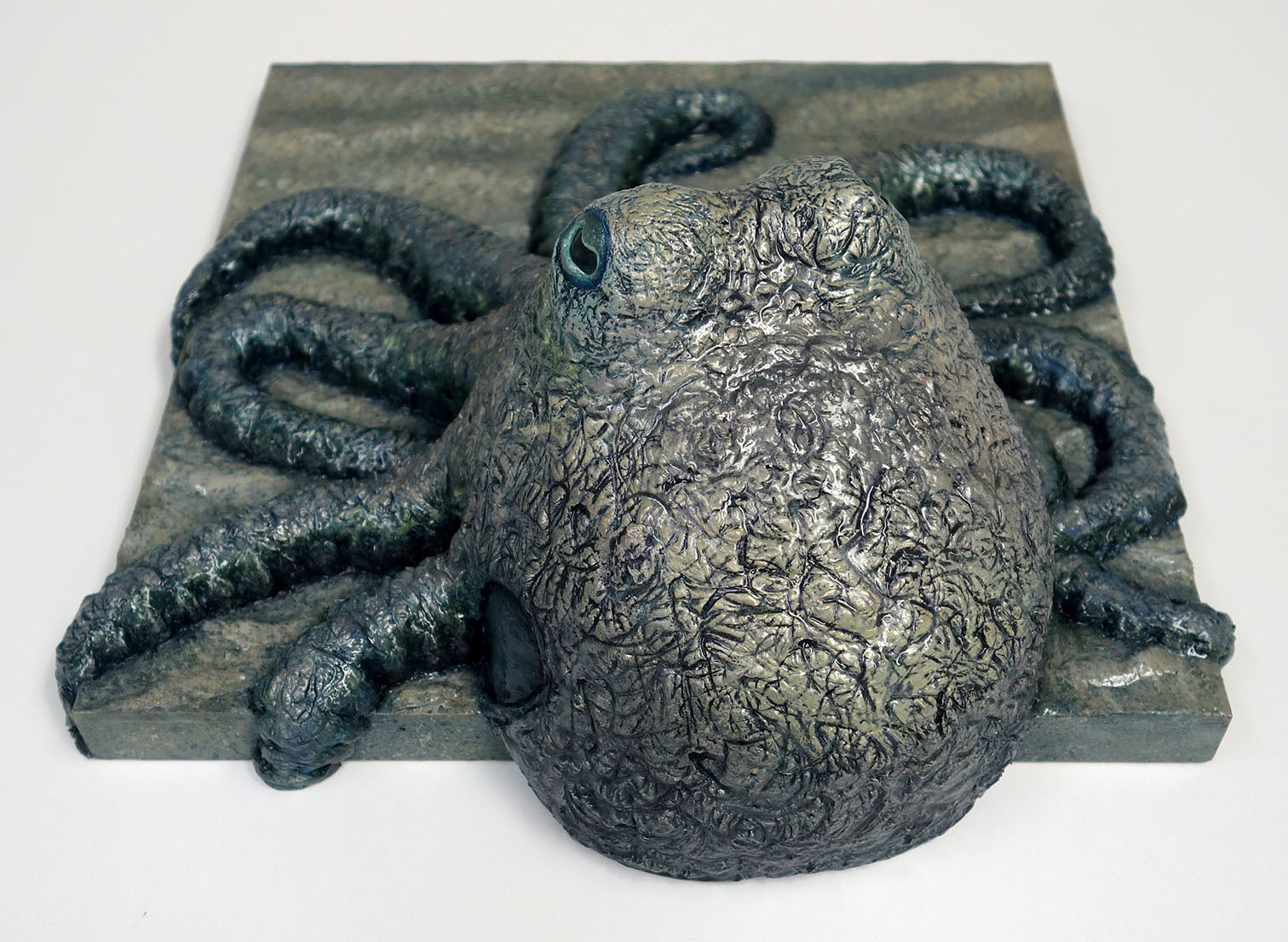
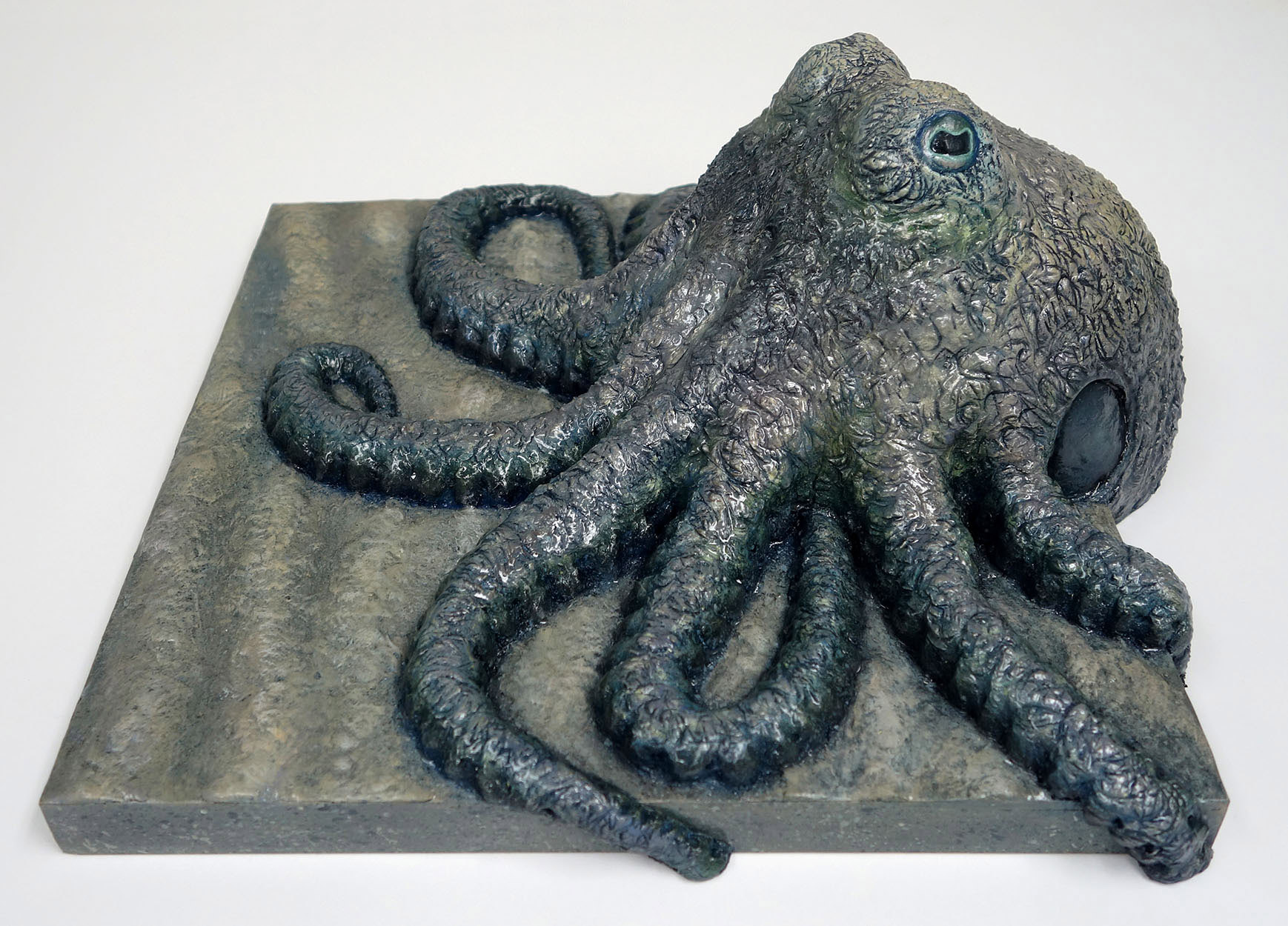

If you’re curious about the sculptural process with QCC, here are a few photos I took along the way. The first two are still in the uncured, sculpting stage and the second two are post-curing but pre-painting. I was actually quite drawn to the piece in its unpainted state, but I had to paint the panel at the very least due to its own mixed media, multicolored composition so I decided to go ahead with painting the whole piece. I might do a different version at some point that’s completely monotone, though, since I liked that quite a lot too.
New Artwork: Guardian
This toad, who I named Reginald, was one of the guardians of my porch this summer and fall. His presence was so regal and dutiful that I felt he required a portrait. He posed for it with the resigned tolerance and grace befitting of a conscientious public servant.
This is Guardian, acrylic on basswood panel, 16x20x1.5”.
New Artwork: Dreamedary
When I began to paint Camelflage, I actually had envisioned a “white on white” concept. However, that painting rapidly began to change direction and I liked where it was going so I let it ride and am happy with how it turned out. I still wanted to paint my original idea, though, so I ordered the same panel size again for continuity and mirrored the camel for a little variation.
This is Dreamedary, acrylic on basswood panel, 12x12x1.5”.
New Artwork: Camelflage
I’m happy with how this turned out! Camelflage is acrylic on basswood panel, 12x12x1.5”.
New Artwork: Puffinry
I haven't actually added paint to this piece in a couple months, but I also hadn't decided it was done either. I'm finally willing to call it and say it's officially finished!
This piece is acrylic on birch panel, 20x10", and is titled Puffinry.
New Artwork: Convergence
Here's a new painting I just finished; I started it during my La Pedrada de Noemi residency, but I didn't get a chance to finish it there so I've been working on it since arriving back home. It's actually the first painting I began while on residency, so given that you might wonder why it took so long to complete - the answer is that the support is an aluminum panel, and I've never worked on aluminum before. What I wanted to do on the aluminum kind of clashed with what the aluminum wanted me to do with it, so we had a prolonged battle. I didn't want to prime or even sand the aluminum, because I feel like the whole point of painting on aluminum is the luminosity of the material. But not priming it meant that the paint wouldn't evenly stick. I feel like I eventually came out the victor, though!
The painting is acrylic on aluminum panel, 18x14", and is titled Convergence. It features a luna moth (Actias luna) atop a barrel jellyfish (Rhizostoma pulmo).
La Pedrada de Noemi Artwork 5
And another one - I've done a piece on a very similar frog in relief before (The Slightest Disturbance), and now here's a painting from a different angle of a marsh frog, Rana ridibunda and/or Pelophylax ridibundus, from the Jardín Botánico Canario Viera y Clavijo. This piece is acrylic on gessobord, 5x7", and is titled Comfort Zone.
La Pedrada de Noemi Artwork 4
Here's a portrait of a lagarto, the Gran Canaria giant lizard Gallotia stehlini! It's acrylic on aquabord, 12x16", titled Volcanic.
La Pedrada de Noemi Assemblages 1 & 2
Here are the two assemblages I created during my sick day - they obviously differ quite a bit from my normal artwork, but I enjoy them nevertheless.
The first I'm titling See Turtle and is made of beachcombed stones, epoxy, and acrylic on a 6x6" birch panel used as a shadowbox. I did not paint or change the appearance of any of the found materials. I did paint the panel.
The second doesn't have a definitive title yet, but perhaps it will be Beachcombing. It is made of beachcombed stones and shells, epoxy, and acrylic on a 6x6" birch panel used as a shadowbox. I did not paint or change the appearance of any of the found materials. I did paint the panel.
I realize they are rather simple, but I like the concept that these were a collaboration between the local people (those who originally used the concrete/stones for construction and decoration), the ocean (which shaped them into what they are today and also contributed the two shells on the second piece) and myself (the arranger). I also enjoy taking departures every now and then from my typical practice!
La Pedrada de Noemi Artwork 3
This piece is rather quiet, even though it features a loud subject - the Ornate Wrasse, Thalassoma pavo. I am particularly pleased with the background, which is in keeping with my overall style but also references the refraction patterns of the ocean. I also think this painting shows that though the Ornate Wrasse is brightly colored, it can blend in surprisingly well.
It is acrylic on pastelbord, 9x12", and I'm still wrestling with the title.
La Pedrada de Noemi Artwork 2
This acrylic on gessobord is quite small - only 5x7" - and purposefully awkward. To me it's simultaneously uncomfortable and amusing. The subject is a redlip or horseface blenny, Ophioblennius atlanticus. I'm titling it Stage Left. This painting also uses iridescent gold in both the background and the eyes, so it too is more arresting in person than in photo.
La Pedrada de Noemi Artwork 1
Here's the first finished piece of artwork from my residency! It features two Canary damselfish, Similiparma lurida and/or Abudefduf luridus. There are a lot of this species in the Zoco Negro where I went snorkeling and had my scuba diving "baptism." The males are territorial, and this species is occasionally called sergeant major (though the name more commonly applies to a different damselfish species). I've decided to name this painting Reconnaissance. It is acrylic on pastelbord, 11x14", and looks even nicer in person because the water and the eyes of the fish have iridescent silver and gold paint on them, respectively, and so they shine intensely depending on viewer angle and interior light levels.
New Artwork!
I just completed a new piece of artwork - the second companion piece to Pilgrim. I had intended to do at least two from the start, but it took a while to find the studio time to devote to the second piece.
In this one, I wanted to achieve a real sense of depth in my relief without being cartoonish. My aim was to maintain the possibility of illusionism from some angles - particularly that of the shallower sections. With Pilgrim, there is a relatively shallow relief over the entirety of the sloth's body. In this new piece, the sloth's body contains an area that is solely painted with no relief at all and then extremely shallow through rather bold relief.
I'm considering titling this one Outreach. It's Quick Cure Clay and acrylic on basswood panel, 12x6x1.75", 2018. Due to the dimensions of the piece, it shows up quite large below; if you click on it though it will open up in an overlay that depending on your monitor and settings will probably be smaller and more of a gestalt.
Below you can see a couple in-progress photos of the relief work before I applied paint.
New Artwork!
I started this piece in Madrid at the Intercambiador ACART residency, but I unfortunately didn't have time to finish it there. So I've been working at it here at home, and recently finished it!
Greylag, acrylic on paper, 11.5 x 15.5".
Intercambiador ACART Residency Journal 12 - New Artwork!
Seriously, I've been really hard at work here creating lots of new artwork!
I went to see the Zoo Aquarium de Madrid a couple weeks ago, mostly because I remember it being huge from when I visited it ten years ago and with unusual access to some of the animals like the giraffes, bears, and wallabies. They've tightened up some of their security since, though I still saw patrons feeding peanuts to lemurs and bears despite the signage (I saw that ten years ago too, but also saw a wallaby with an entire bagel and giraffes also being fed peanuts by the crowd!), and it still seemed big but not quite as huge as it did when I was younger.
I typically don't paint zoo animals; I prefer to paint animals that are local and/or native to the places I'm inhabiting, and I also don't think I get very unique perspectives on many zoo inhabitants unless the zoo is one of the few that has surprisingly close access to the animals. However, this time around despite less access than I remember (though still on the more access side of zoos), a giant anteater had escaped from his enclosure and was having the time of his life in the green space between his enclosure and the public walkways. There was still a small fence between him and the walkways, but honestly, the fence he escaped from was much more difficult to surmount so while he could've escaped full-stop, I believe he just preferred the green space to that of his desert-themed enclosure. If I'd wanted to, I could've touched him, but I didn't - both because I'm a good zoo visitor, and also because he was a fighter! Peahens, unaware of his escape, were pecking around happily when he ran over and began repeatedly charging them. He did that until they hid behind some bushes and then he happily commenced wandering around the green space, digging and eating in the grass. I watched him for a while and then went off to other parts of the zoo; I returned a few hours later and he somehow got his girlfriend out as well! I think the Zoo must know they can escape, but I'm honestly surprised it's allowed since unwise guests could really cause a problem quite easily with the anteaters...
Watching him enjoy himself so much (and having an exceptional amount of access to him), it felt like I actually did get a real glimpse into his character. I left wanting a souvenir of the experience, and in my mind there's no better souvenir than painting him.
Dominion, acrylic on canvas, 25x39 3/4".
